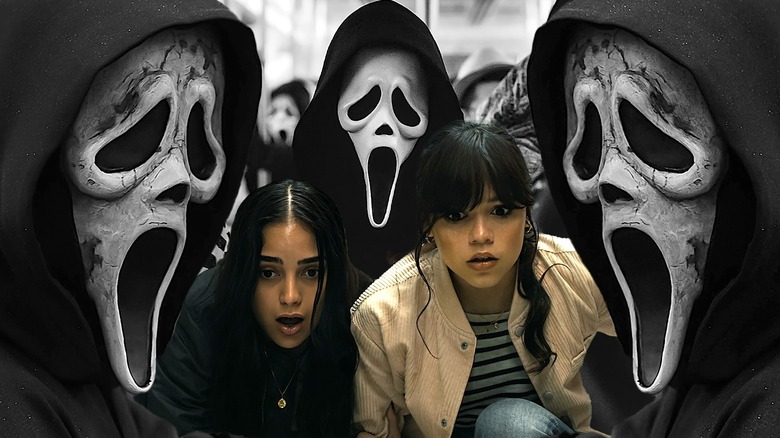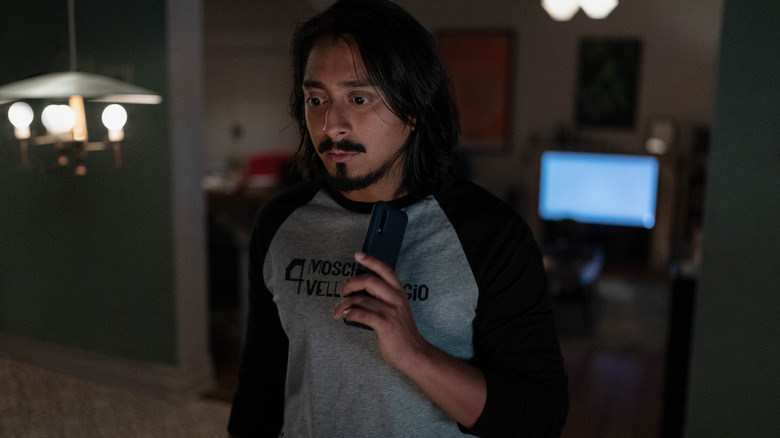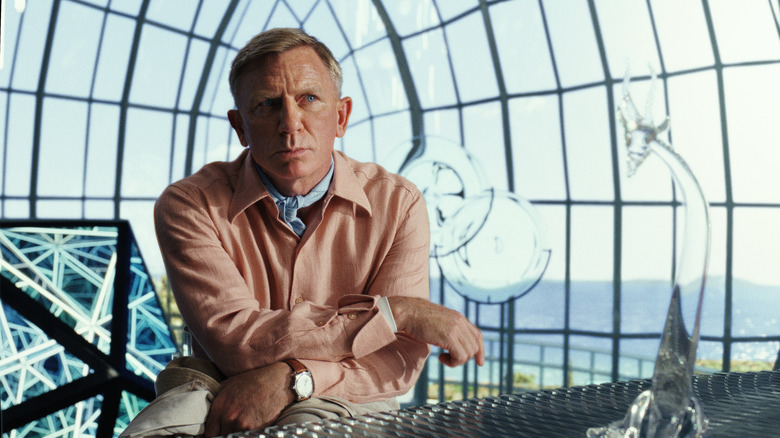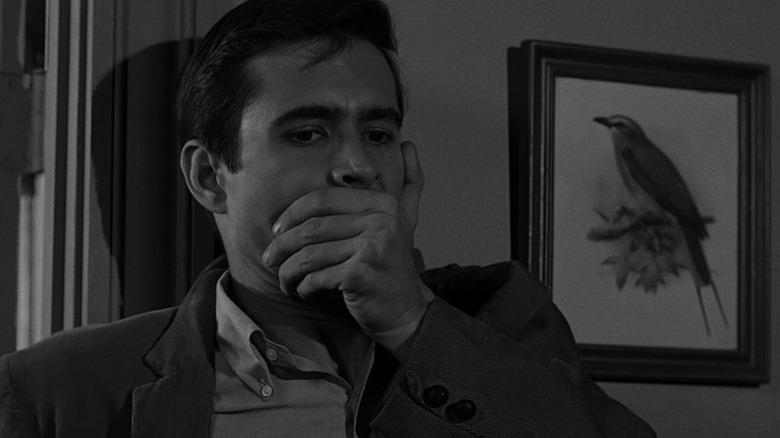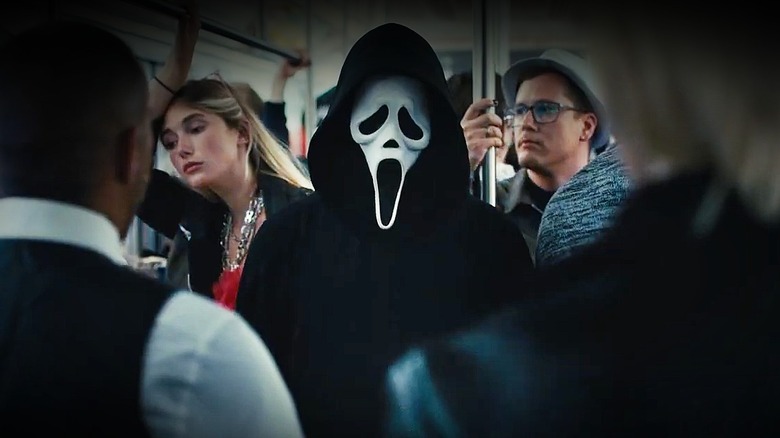The Scream 6 Opening Sequence Is Proof That The Series Can (And Should) Move Beyond Spoilers
This article contains light spoilers for "Scream VI."
It's 2023, and the threat of spoilers still holds sway over the majority of the moviegoing and TV watching populace. On the one hand, it's not hard to see why this is the case: live commentary and reactions on social media platforms are as rampant as ever, and the disparity of people's viewing habits (not to mention spending capabilities, between high theater prices and subscription fees up the wazoo) means that not everyone is able to see the thing at the same time.
However, while understandable, the weight that the whole "spoiler" concept maintains is not a healthy or necessary one. Yes, plot elements can be "spoiled," ruining an idealized first experience with a work. Any worthwhile story, however, should be truly spoiler-proof.
One of the earliest franchises to try and lock down spoilers during its production is the "Scream" series. Although writer Kevin Williamson spent years refining the original script for "Scream" without worrying about anyone revealing who the killers were, as soon as 1997's "Scream 2" went into production there were "dummy scripts" written and distributed – a series tradition that continued up to 2022's "Scream," which shot alternate versions of the ending to throw off potential leaks.
The latest installment, "Scream VI," features a clever, bravura fake-out in its opening sequence, another tradition of the franchise. However, this particular twist is one that seems to hint at a potential bold new direction for the series, one that could remove the need for the increasingly elaborate attempts to keep the films pure for as many viewers as possible.
Unmasking in the first reel
In the opening of "Scream VI," we're introduced to Laura Crane (Samara Weaving), a beautiful blonde professor who's eagerly awaiting her online date at a swanky New York City restaurant. When she gets a text and then a phone call from her date, he explains how he's become lost while trying to find the restaurant (a fairly relatable occurrence in NYC — I speak from experience), and coaxes Laura outside to try and help him find his bearings.
Once there, the man lures Laura into a dark alley, at which point his voice changes to the familiar Ghostface voice (Roger L. Jackson, returning to the role once again) before Ghostface himself emerges from the shadows and stabs Laura to death. Gloating over her dead body, Ghostface then does something even more unimaginable: he removes his mask, revealing himself to be one of Laura's film studies students, Jason Carvey (Tony Revolori).
The scene continues, following Jason back to his dorm, pausing for a moment as Jason greets Tara Carpenter (Jenna Ortega) on her way to a frat party. So far, it seems like the film is actually letting the audience in on Ghostface's identity (or at least, one Ghostface — there are usually multiple killers) right in the first reel.
However, once Jason is in his dorm room, he receives a call from his partner, Greg, and it quickly becomes clear that the real Greg is already dead and Jason's on the phone with yet another Ghostface. Sure enough, the film's real Ghostface (or, again, one of them) pops out, stabbing Jason to death and concluding a clever rollercoaster of an opening.
Whodunits are having a moment, so why not go against the grain?
With this opening, "Scream VI" plays with audience expectation and the series' conventions in a clever, metatextual way ... before settling back down into the franchise's usual mode of a movie-long whodunit.
Here's the thing: Why couldn't the film have revealed its actual killer (or killers) so early on? It would have made for an even bolder choice, and one that could set the series (which, after all, is on its sixth installment) on an exciting new path.
Perhaps one reason why directors Matt Bettinelli-Olpin and Tyler Gillett (collectively known as Radio Silence) along with writers James Vanderbilt and Guy Busick didn't take this route is because whodunits are kind of having a moment right now. In addition to the myriad procedural murder mystery shows still airing on network television (where the genre has essentially become a standard), Kenneth Branagh has resurrected Agatha Christie's Hercule Poirot mysteries with 2017's "Murder on the Orient Express" and 2022's "Death on the Nile."
Meanwhile, Rian Johnson has created his own answer to Poirot with Benoit Blanc, detective protagonist of "Knives Out" and last year's "Glass Onion." That's not all Johnson's done with the genre: he's also behind the Peacock streaming series "Poker Face," starring Natasha Lyonne as casino worker and murder mystery solver Charlie Cale.
It's easy to see why the "Scream" series, with its reputation, would want to revel in this moment that the whodunit genre is having. Yet with all this competition, the "Scream" films could actually set themselves apart by zigging where everyone else is zagging and revealing its killers up front to set the audience even more on edge.
The Hitchcockian theory of suspense
This technique of revealing what would normally be the twist upfront is not at all new. In fact, the filmmaker once dubbed "The Master of Suspense," Alfred Hitchcock, often swore by it.
Hitchcock typically explained his theory of suspense over shock thusly: there are two people sitting at a table and talking when suddenly a bomb goes off. That occurrence provides a great shock for the audience, but it's a short-lived sensation. However, if the audience was let in on the fact that a bomb was under the table before the two people sat down and began talking, that would invoke the sensation of suspense, which is far more insidiously effective as a source of tension and terror. (For further elucidation, here's Hitch himself explaining it.)
Examples of Hitchcock employing this theory can be seen throughout the director's films, from 1936's "Sabotage" (which literally uses a bomb in its most suspenseful sequence) to 1958's "Vertigo," which does away with its crime plot early on to better focus on the movie's twisted protagonists.
If the next "Scream" film were to take a page out of Hitchcock's book, it would be doubly clever. For one thing, Hitchcock is arguably the granddaddy of the slasher genre, having made "Psycho" (which Billy Loomis gleefully quotes during the first "Scream"), and thus the series would do well to follow his lead. For another, the concept of revealing the killer or killers early in the film instead of deep in the third act would give the potential seventh (or eighth, or ninth!) "Scream" movie a fresh vibe. While "Scream VI" is a ton of fun, there's no denying that things are starting to feel a little too formulaic in Ghostface-land.
Keep the audience guessing
Ultimately, the opening sequence of "Scream VI" is a winner because it satisfies the core ethos of the "Scream" franchise, which is to keep the audience tense (if not scared) by keeping them guessing. The series' biggest strength lies in combining its charming characters with its penchant for brutal cruelty — all bets are off, anyone could die, and anyone could be the killer.
The series has never gone too far in betraying its audience's trust; Sidney Prescott (Neve Campbell) was never revealed as a new Ghostface, for example. Yet the threat of surprise is still very much alive in the films (Sam Carpenter just can't stop seeing visions of Billy, it seems...!), which is why the "Scream VI" opening feels credibly groundbreaking up until it's not.
As Randy Meeks (or his niece Mindy Meeks-Martin) would likely tell you, sequels get stale the longer and harder they adhere to formula, and "Scream" could be facing that issue fairly soon, especially if the series is allowed to devolve into merely a quaint guessing game. Moving beyond the "who's the killer?" spoiler question could be just the shot in the arm this series needs, and create the perfect sense of unnerving tension and fear that Radio Silence— not to mention Ghostface — wants us to feel.
"Scream VI" is in theaters now.
